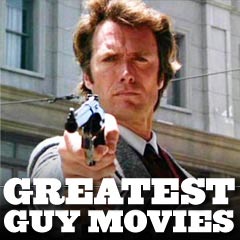
|
of All-Time 1966-1969 |
![]()
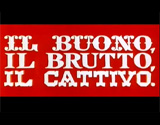 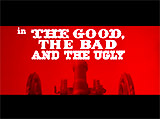
|
The Good, the Bad, and the Ugly
(1966, It.) This western was the third and final installment (but actually a prequel) in under-rated Italian director Sergio Leone's The Man with No Name epic trilogy. It is perhaps the best-known "spaghetti western" of all-time. See Greatest Scenes: The Good, the Bad, and the Ugly for a more complete summary. The film's opening title sequence included a 20 minute introduction to the three main characters: Tuco "the Ugly" (Eli Wallach), Sentenza "the Bad" (Lee Van Cleef), and Joe "the Good" or "Blondie" (Clint Eastwood). 'The Man with No Name' was Eastwood's star-making role, after he made appearances in the previous A Fistful of Dollars (1964) and For a Few Dollars More (1965). Elements of his character could be found in his later anti-hero cop "Dirty" Harry Callahan character in Dirty Harry (1971). As with Leone's other westerns, this film was viciously violent and machismo in tone, but buoyed by the classic, instantly-recognizable, twanging Ennio Morricone score, very little dialogue, lots of closeups, and vast widescreen landscapes. The film's plot, set during the Civil War, concerned the acquisition of a "cash box" of $200,000 in stolen Confederate gold coins buried in a grave at a faraway cemetery location. All three of the main characters, basically amoral, anti-social bounty hunters, outlaws, and murderers, were forced to form an uneasy partnership or alliance, leading to the film's climactic graveyard shootout in which the opportunistic desperados found themselves facing off one last time for the fortune.
"When you have to shoot, shoot. Don't talk." "You see, in this world there's two kinds of people, my friend. Those with loaded guns and those who dig. You dig."
The opening credits sequence to introduce the main characters, and the final cemetery shoot-out scene. |
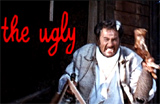 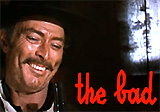 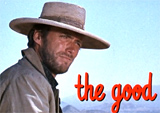 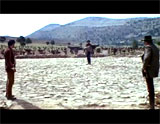 The Climactic Face-Off and Shoot-out at the Graveyard |
||||
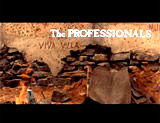
|
The Professionals (1966) Writer/director Richard Brooks' big-budget ensemble western was one of the most exciting action-adventure westerns of all time. It starred Lee Marvin as munitions expert Henry "Rico" Fardan - the leader of a four-man mercenary team in the final years of the Mexican Revolution. See Greatest Scenes: The Professionals for a more complete summary. The 'professionals' included Burt Lancaster as dynamiter Bill Dolworth, Robert Ryan as horse specialist Hans Enrengard, and Woody Strode as tracker/longbow expert Jake Sharp). Both Dolworth and "Rico" had fought with Pancho Villa's forces during the revolution.
They went into Mexico on a dangerous mission to rescue a wealthy industrialist's ransomed or 'kidnapped' wife (the beautiful Claudia Cardinale) from Mexican rebel kidnappers (headed by Jack Palance as guerrilla leader Jesus Raza, "the bloodiest cutthroat in Mexico" - although highly respected by both Dolworth and "Rico") - a job commissioned by Texas railroad tycoon/millionaire Joe W. Grant (Ralph Bellamy). At film's end, a character reversal was revealed - Maria actually loved the Mexican outlaw that she had been kidnapped from. The "professionals' abandoned their "bad deal" mission as Rico explained to Grant: "We made a contract to save a lady from a nasty old kidnapper. Who turns out to be you" - they allowed Maria to leave with the wounded Raza to return to Mexico. In the film's curtain closing, Dolworth summarized: "We both made a bad deal, Mr. Grant. You lose a wife and we lose $10,000 dollars apiece." Grant (To Rico): "You bastard!" Rico (with a witty reply): "Yes, Sir. In my case an accident of birth. But you, Sir, you're a self-made man."
"So what else is on your mind besides hundred-proof women, 'n' ninety-proof whiskey, 'n' fourteen-carat gold?" "The question is, Who are the good guys?" - "We both made a bad deal, Mr. Grant. You lose
a wife and we lose 10,000 dollars apiece."
The mass execution of federal troops by Raza. The assault on Raza's compound. |
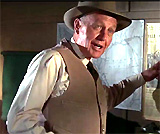 J.W. Grant (Ralph Bellamy) 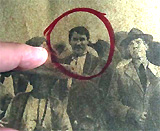 Alleged "Kidnapper" Capt. Jesus Raza (Jack Palance) 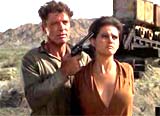 Maria - Successfully Captured - And Used As a Bargaining Chip to Escape 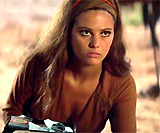 Dolworth Looking at Maria's Cleavage 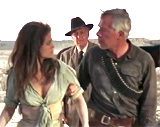 Rico Assisting Maria to Return Home with Raza  Grant (To Rico): "You bastard!" Rico: "Yes, Sir. In my case an accident of birth. But you, Sir, you're a self-made man." |
||||
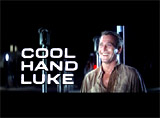
|
In director Stuart Rosenberg's popular prison chain-gang drama with numerous Christ references and images - it was based upon Donn Pearce's novel, and presented a moving character study of a non-conformist, anti-hero loner who bullheadedly resisted authority and the Establishment. See Greatest Scenes: Cool Hand Luke for a more complete summary. An irreverent, rebellious, stubborn, unruly, independent-minded, spirited title character was a social misfit named Luke (Paul Newman) who was arrested for maliciously destroying municipal property (he cut the heads off parking meters); he was subsequently sentenced to two years' imprisonment in a tough Southern prison farm, commanded by sadistic, prison officer Captain (Strother Martin). In the film's most titillating scene, a blonde-haired, shapely, well-endowed and sexy young woman (Joy Harmon) in a nearby house prepared to wash her car. Her provocative activity sent the men into a voyeuristic, frustrated frenzy; she frustrated the prisoners by soaping up, pressing her sudsy breasts against a car window, and hosed off herself and her car in plain sight (Luke: "She knows exactly what she's doin'. She's drivin' us crazy and lovin' every minute of it.") An epic brutal boxing match was fought between chain-gang boss convict Dragline (George Kennedy) and Luke, who refused to give up by staying down on the ground - and thereby received a severe beating; after boxing with Dragline, Luke eventually became a hero to his fellow inmates, earning Dragline's name for him - "Cool Hand Luke" - because his will could not be broken. Luke was visited at prison by his sick and dying mother Arletta (Jo Van Fleet) who talked to him from the back of a pickup truck; the visit revealed facts about his difficult upbringing and past. During one of the film's most light-hearted segments, Luke participated in an hour long, hard-boiled egg-eating contest that he won by consuming 50 eggs. Shortly later following news of the death of his mother, Luke strummed a banjo singing the irreverent "Plastic Jesus" song. As the inmates started worshipping him as a folk hero, he refused to submit and continually and cooly defied the authorities with repeated escape attempts. The nasty prison boss Captain delivered a famous line to the defiant Luke after beating him in front of the men: "What we got here is failure to communicate." Luke risked everything in order to live up to their expectations, and was sacrificed in the tragic climax. After Luke's third escape attempt, he sought refuge in an abandoned country church. Luke sat in one of the church's pews and delivered a very memorable, rambling monologue; he talked to God and asked for guidance and help. In the reddish light of the cherry-topped police cars that drove up with prison officers, Luke went to the church window and looked out on the Captain and the others - and mocked the Captain with his own words:
Luke was tragically shot in the throat and silenced forever by the crack-shooting, sunglasses-wearing Boss Godfrey (Morgan Woodward) with no eyes. Luke died in the back seat of the Boss' car - his face wore the familiar enigmatic grin - a Christ-like image and sign of the victory of his spirit over death. In a final montage sequence, Dragline favorably remembered and resurrected his martyred hero while telling the story of his death to his convict-compatriots - it provided Luke's epitaph: "Old Luke, he was some boy. Cool Hand Luke. Hell, he's a natural-born world-shaker."
"What we got here is (a) failure to communicate." "Old Luke, he was some boy. Cool Hand Luke. Hell, he's a natural-born world-shaker."
The soap-sudsing car wash performed by a buxom blonde (Joy Harmon). The egg-eating contest. Luke's memorable monologue with God before his murder (and silencing forever). |
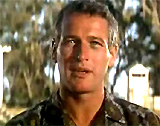 Rebel Prisoner Luke (Paul Newman) 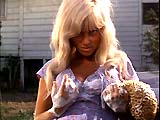 Teenager Performing a Soapy and Sexy Car-Wash 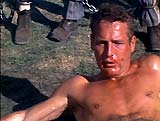 Luke's Boxing Match against Dragline 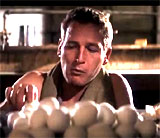 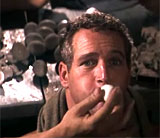 Luke's Egg-Eating Contest Luke's Egg-Eating Contest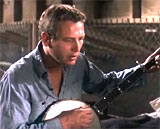 Luke Strumming a Banjo and Singing: "Plastic Jesus" After His Mother's Death 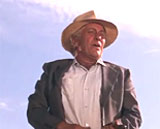 The Captain's Words to the Defiant Luke: "What we got here is failure to communicate" 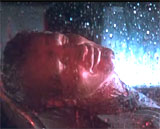 Reddish Glow After Being Shot and Silenced Forever in a Country Church |
||||
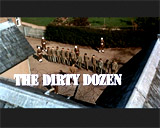
|
The Dirty Dozen (1967) This popular action-war film from director Robert Aldrich, the ultimate WWII 'guy's' movie - featured exciting sequences of the training and then the behind-the-lines suicidal mission and assault (named "Operation Amnesty" composed of 16 separate steps) on a Nazi-filled French chateau by a group of a dozen undisciplined, convicted, anti-social, death-row military convicts and murderers and other criminals, known as "The Dirty Dozen." See Greatest Scenes: The Dirty Dozen for a more complete summary. The film was partly based, with Hollywood embellishment, on a elite but disruptive group of demolition commandos known as "The Filthy Thirteen" (from the 101st Airborne Division) who didn't conform to the Army's grooming standards and basic hygiene. In the mid-80s, the film was revived with various made-for-TV movies, including The Dirty Dozen: The Next Mission (1985), The Dirty Dozen: The Deadly Mission (1987), and The Dirty Dozen: The Fatal Mission (1988). It was similar to other films at the time with large ensemble casts of stars brought together, such as The Bridge on the River Kwai (1957), The Magnificent Seven (1960), How the West Was Won (1962), The Longest Day (1962), The Great Escape (1963), It's a Mad, Mad, Mad, Mad World (1963), and The Professionals (1966) - in this one, the stars included Telly Savalas, Donald Sutherland, Jim Brown, John Cassavetes, Charles Bronson, Robert Ryan, George Kennedy and more. The war film was extremely popular - it became MGM's highest grossing film of the year, with domestic revenue of $45.3 million on a budget of $5.4 million. In the aftermath of the mission, the only 'Dirty Dozen' survivor was Wladislaw (Charles Bronson). During a concluding montage, a roll call of the faces of the 11 men who lost their lives in the line of duty was reviewed during the end credits.
"...It gives you just about the most twisted, anti-social bunch of psychopathic deformities I have ever run into!...You've got one religious maniac, one malignant dwarf, two near-idiots, and the rest I don't even wanna think about!" "Killing generals could get to be a habit with me." Homage to Da Vinci's 'The Last Supper.' Jefferson's (Jim Brown) heroic run - to touch off the massive explosion of the chateau after being commanded: "All right, blow it!" Concluding montage of 11 'Dirty Dozen' members who lost their lives. |
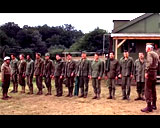 Twelve Insubordinate Men in a Line-Up 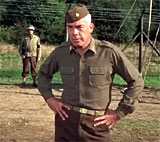 Major Reisman (Lee Marvin) 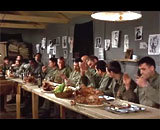 Homage to Da Vinci's 'The Last Supper' 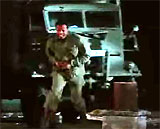 Jefferson's Heroic 20 Second Sprint 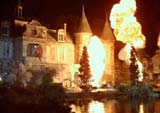 French Chateau Explosions |
||||
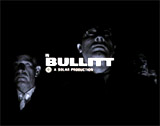
|
Bullitt (1968) In this Warner Bros.' classic car-chase/cop film by director Peter Yates (his second film) with his first American film - the suspenseful, police crime-thriller was based upon Robert L. Fish's (aka Robert L. Pike) 1963 novel Mute Witness, and adapted by Alan R. Trustman & Harry Kleiner; it was enhanced by Lalo Schifrin's jazzy and brassy Original Music Score, and was honored with the Best Film Editing Academy Award (for its central chase sequence no doubt, one of the most quintessential film segments in all of cinematic history); it was also nominated for Best Sound. See Greatest Scenes: Bullitt for a more complete summary. In the complex, murky storyline with a plot twist, early 30s, brown-haired SFPD detective Lieutenant Frank Bullitt (Steve McQueen) was pressured by aspiring, well-connected, antagonistic politician Walter Chalmers (Robert Vaughn), to take "an important job" - to help protect a star witness ('Johnny Ross') from Chicago until his appearance to testify and provide "states's evidence" at a Senate Subcommittee hearing against the mob (the "organization") on Monday morning (40 hours into the future); Chalmers bluntly stated his own interest in furthering his career. During the "babysitting" job at the place rented for 'Ross' by Chalmers - a cheap, dingy flophouse (at 226 Embarcadero Rd., Room # 634) known as the Daniels Hotel, at 1 AM, two professional hit men (later identified as white-haired, 5 ft. 10 inches tall Mike (Paul Genge) and backup driver Phil (Bill Hickman) wearing glasses) burst in, kicked the door down, and with a Winchester pump-action shotgun, shot Sgt. Carl Stanton (Carl Reindel) in the left thigh (and kicked in the face), while Ross was seriously injured when shot in the chest and neck. After an attempt in the hospital to save Ross' life, he died. Through gritty detective work and questioning with his partner Detective John "Dell" Delgetti (Don Gordon), Bullitt worked the case, and uncovered many different twists and complex situations. He was informed that Ross had fled from the mob syndicate in Chicago, because he had stolen $2 million dollars from "The Outfit." The film's most memorable sequence began when Bullitt realized he was being pursued by the two hit-men who had killed the protected witness. The spectacular, high-speed, nine minute car pursuit-chase sequence was conducted up and down the narrow, hilly streets of San Francisco and through hazardous intersections (with airborne vehicles), and then onto a winding 2-lane road near Brisbane in the north Bay, with multiple crashes and collisions. At the start of the scene, Bullitt reversed things and pursued the hitmens' car; the classic chase ended when Bullitt side-swiped their car and it lost control, veered off the road, and plowed into a gas station - with a fiery explosion. The film's plot twist was later revealed in the police headquarters -- the man killed in the Daniels Hotel was not 'Johnny Ross' but a doppelganger named Albert Renick (Felice Orlandi), a Chicago used car salesman; the real Johnny Ross (Pat Renella) had paid Renick to be his double and a decoy, so that Ross could escape from the country on a 7 o'clock flight to Rome on Sunday night and avoid testifying for Chalmers the following week; Bullitt chided Chalmers: "You sent us to guard the wrong man, Mr. Chalmers." The film concluded with a tense sequence in the SF Airport's Pan Am building (with Bullitt and Delgetti in pursuit, and Chalmers also present), where the crafty mobster Johnny Ross was tracked down, shot and violently killed.
"You work your side of the street and I'll work mine." "Look, Chalmers, let's understand each other. I don't like you."
The impressive opening titles sequence. The extended San Francisco car chase scene - the moment when Bullitt's car appeared BEHIND the hitmens' car - seen in their rear-view mirror. Girlfriend Cathy's (Jacqueline Bisset) long devastating lecture to Bullitt on the site of the road on a drive back to SF, about what his job was doing to his psyche and their relationship. The concluding segment at the SF Airport where Bullitt pursued mobster Johnny Ross across the tarmac while avoiding taxiing commercial jetliners. |
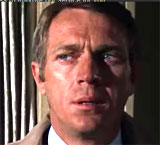 Lieutenant Frank Bullitt (Steve McQueen)  Walter Chalmers (Robert Vaughn) 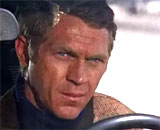 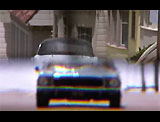 Bullitt Behind Hitmens' Car, Viewed in Rear View Mirror 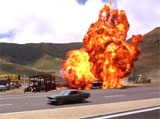 Violent Crash of Hitmens' Car 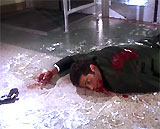 Ross Shot Dead at Airport - Through Plate Glass Door |
||||
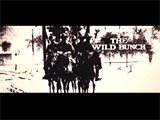
|
Co-writer/director Sam Peckinpah's violent, provocative, brilliant yet controversial western, one of the masterpieces of cinema, was shocking for its graphic and elevated portrayal of violence and savagely-explicit carnage, yet hailed for its truly realistic and reinterpreted vision of the dying West in the early 20th century. Its unrelenting, bleak tale told of aging, scroungy outlaws (the 'wild bunch') bound by a private code of honor, camaraderie and friendship, but they found that they were at odds with the society of 1913. See Greatest Scenes: The Wild Bunch for a more complete summary. The ultra-violent western was exceptional for its non-glorification of bloodshed, and its slow-motion, heavily-edited, stylized views of multiple deaths. It increased the acceptance and tolerance level for violence on the screen - a lasting influence that has been seen in the imitative graphic violence of the films of Martin Scorsese, Quentin Tarantino, John Woo, and others. The lone band of men led by Pike Bishop (William Holden) came to the end of the line and were no longer living under the same rules in the Old West, and were relentlessly stalked by bounty hunters, one of whom was Pike's former friend and gang member Deke Thornton (Robert Ryan). The much-imitated, influential film was book-ended by two extraordinary sequences, both massacres. The gang of desperadoes were first assaulted in the film's opening ambush following a failed railway payroll office robbery in a Texas border town. And then in the film's conclusion, they were brutally destroyed as united comrades in a selfless, redemptive act - by a savage and vindictive Mexican warlord after a double-crossing arms deal. It was a spectacular, climactic bloodbath in an open courtyard in the rural Mexican village of Agua Verde, as the gang took on an entire Mexican soldier regiment, led by ruthless, double-crossing General Mapache (Emilio Fernandez), as they commandered a big machine gun for awhile.
"If they move, kill 'em."
The film's opening ambush following a failed railway office robbery in a Southwestern Texas border town. The bloody finale signaled by the courageous, heroic march of the four remaining gang members to face ruthless General Mapache and his army for a showdown - a slow-motion massacre-shoot-out as the Wild Bunch suicidally attempted to rescue fellow member Angel (Jaime Sanchez) from 200 Mexicans. |
 Opening Titles Sequence  Leader Pike Bishop (William Holden): "If they move, kill 'em" 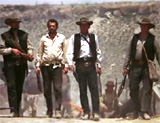 Four Gang Members Marching to Face General Mapache in Closing Showdown 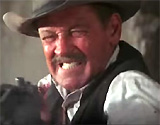 Pike with Browning Machine Gun |
||||